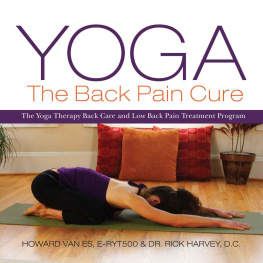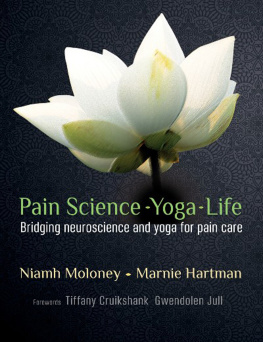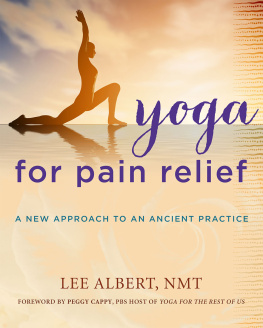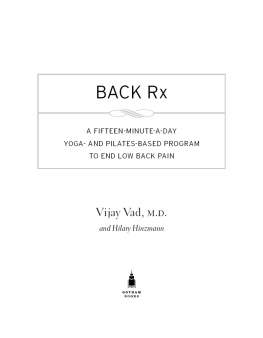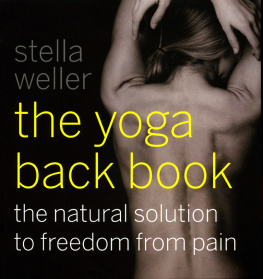Howard VanEs - Yoga : The Back Pain Cure
Here you can read online Howard VanEs - Yoga : The Back Pain Cure full text of the book (entire story) in english for free. Download pdf and epub, get meaning, cover and reviews about this ebook. year: 2014, publisher: BooksOnHealth, genre: Science / Home and family. Description of the work, (preface) as well as reviews are available. Best literature library LitArk.com created for fans of good reading and offers a wide selection of genres:
Romance novel
Science fiction
Adventure
Detective
Science
History
Home and family
Prose
Art
Politics
Computer
Non-fiction
Religion
Business
Children
Humor
Choose a favorite category and find really read worthwhile books. Enjoy immersion in the world of imagination, feel the emotions of the characters or learn something new for yourself, make an fascinating discovery.
- Book:Yoga : The Back Pain Cure
- Author:
- Publisher:BooksOnHealth
- Genre:
- Year:2014
- Rating:5 / 5
- Favourites:Add to favourites
- Your mark:
- 100
- 1
- 2
- 3
- 4
- 5
Yoga : The Back Pain Cure: summary, description and annotation
We offer to read an annotation, description, summary or preface (depends on what the author of the book "Yoga : The Back Pain Cure" wrote himself). If you haven't found the necessary information about the book — write in the comments, we will try to find it.
Yoga : The Back Pain Cure — read online for free the complete book (whole text) full work
Below is the text of the book, divided by pages. System saving the place of the last page read, allows you to conveniently read the book "Yoga : The Back Pain Cure" online for free, without having to search again every time where you left off. Put a bookmark, and you can go to the page where you finished reading at any time.
Font size:
Interval:
Bookmark:
Yoga
The Back Pain Cure

Yoga: The Back Pain Cure
The Yoga Therapy Back Care and Low Back Pain Treatment Program
Howard VanEs, M.A. E-RYT 500 and Dr. Rick Harvey, D.C.
Published by:
BooksOnHealth.net
ISBN: 978-0615986364
Copyright 2014 by Howard VanEs, M.A. and Dr. Rick Harvey. All rights reserved. Unless otherwise noted, no part of this book may be reproduced, stored in a retrieval system, transmitted in any form or by any means, electronic, mechanical photocopying, or recording without express written permission from the author, except for brief quotations or critical reviews.
Disclaimer: The information and ideas in this book are for educational purposes only. This book is not intended to be a substitute for consulting with an appropriate health care provider. Any changes or additions to your medical care should be discussed with your physician. The authors and publisher disclaim any liability arising directly or indirectly from this book.
Acknowledgements
With deep gratitude, wed like to thank all of our teachers, patients, and students past, present, and future. Without them this work would not be possible.
We would also acknowledge and thank our yoga model: Suraya Keating
Table of Contents
Introduction
If youre reading this book, chances are very good that that either you or someone you love is experiencing lower back problems. In fact, over 80% of people in the U.S. will have back problems at some point in their lives. Thats 240 million people, of which 20% to 30% at any one time will have back problems.
And as anyone with back challenges can attest, back problems are not a lot of fun. Back pain, limited activities, and days missed from work all take their toll physically, financially, and emotionally.
Back problems occur for a variety of reasons including accidents, disease states like arthritis, genetic factors, and lifestyle issues.
One of the big problems with most back care programs is that there have been limited treatment options. Pain medications often just mask problems, allowing further damage to occur because you dont feel the pain. Physical therapy treatment is often limited by what the insurance companies deem necessary, and lastly surgery, a very costly option that is becoming more effective, still often fails.
The good news is that yoga therapy can help relieve your pain while at the same time, improve your flexibility and strength. And because yoga is a practice for the entire mind and body, most people find they sleep better, their mood improves, and they enjoy an enhanced sense of overall well-being.
For over 5000 years, yoga has been helping people find balance in their lives and improve the health of their body, mind, and spirit. Today, yogas extraordinary popularity is a testament to its profound ability to heal some 20.4 million people are practicing yoga in the US (according to Yoga Journal).
Two pioneers in the application of yoga therapy for back care are Howard VanEs, M.A., E-RYT500 and Dr. Rick Harvey. Howard is a yoga instructor with over 18 years of teaching experience, and Dr. Rick Harvey is a chiropractor with over 36 years of experience. They have worked together to develop a systematic approach for using gentle yoga postures to address lower back care problems. Their program has become so successful that 93% of people with lower back problems who use it either completely heal or significantly reduce pain and regain flexibility.
As you read through this book, you will gain an understanding of the different types of lower back problems, why they occur, what you can do to prevent them and minimize pain and symptoms.
In the first aid section, you will discover highly effective natural methods for dealing with pain, and, in the lifestyle section, well share some tips to keep back problems from becoming a problem in the first place.
In the yoga therapy section of this book, there are two practices. The first is for people who have acute lower back problems. In other words, you are in pain and discomfort right now. This practice is designed to bring structural balance back into the body and gently stretch key muscle groups and thereby reduce pain and help you heal. The second practice is designed to build strength and flexibility and is more of a maintenance practice. This practice is recommended once pain has regularly subsided using the first practice usually after 2 4 weeks. The second practice may also be used by anyone without active back problems who would like to prevent them in the future.
The bottom line is that the information in this book is going to help you get back into the activities and lifestyle you enjoy, without drugs, without costly treatments, in the comfort of your home, and youll be more in control of your own health as well.
While it might be tempting to skip to the yoga section of the book, it is highly recommend that you read through the first few chapters as it will provide you with a lot of insight about back problems and make the yoga practice more meaningful.
Yoga therapy can help relieve your pain while at the same time improve your flexibility and strength, and get you back into the activities you enjoy.
Causes of Lower Back Problems
In this chapter, well take a look at why so many people develop back problems. As you will discover, there are many reasons why back problems can occur, some of which are out of our control and some of which we actually have a lot of control over, such as lifestyle factors. In the next chapter, we will give you a brief overview of anatomy so you can get a clear picture of what is happening on the inside when you have back problems.
Accidents
One of the major causes of back problems is accidents. Take a moment to think about the ways accidents might happen:
- Slipping and falling down
- Tripping over the dog
- Missing a step on the stairs and falling down
- Climbing down from a ladder and missing the last rung
- Having a minor car accidentthat little bump in a parking lot
- Having a major car accident
- Sports injury
- Bumping into a door or a wall
- Stepping off a curb the wrong way
- Lifting a heavy package the wrong way

These are just a few of the more common accidents we hear about, but the way people have accidents is almost as diverse as people themselves.
The reason why accidents often lead to low back problems is that forces of the accident push the normal healthy functioning of your muscle-skeleton system out of balance. This imbalance may show up right away as excruciating pain, or it may not show up for weeks or months down the road.
Have you ever noticed a person walking with his or her leg in a cast? The added height of the cast will raise the hip on the side of the injury. Lets say you injured the right leg. The raised right hip will cause the spine to list to the left side away from vertical. You wont walk around bending to the left for very long because the muscle of the lower back will begin pulling your upper body back to the right, so that your eyes will be level. However your spine will now be twisted back to the right.
The muscle and ligaments of your spine will conform to the new position which will, in actuality, further cause strain and sprain. This will become your new normal. When you get the cast off after a few weeks, your leg length will be level, however your spine will now be curved to the right. The ligaments and muscle will now have to adapt to the new position. Many times this can cause new or additional ligament and muscle pain. Proper rehabilitation of this area is essential and can be accomplished by a regular practice of yoga which will help provide a balance to the musculature.
Next pageFont size:
Interval:
Bookmark:
Similar books «Yoga : The Back Pain Cure»
Look at similar books to Yoga : The Back Pain Cure. We have selected literature similar in name and meaning in the hope of providing readers with more options to find new, interesting, not yet read works.
Discussion, reviews of the book Yoga : The Back Pain Cure and just readers' own opinions. Leave your comments, write what you think about the work, its meaning or the main characters. Specify what exactly you liked and what you didn't like, and why you think so.

